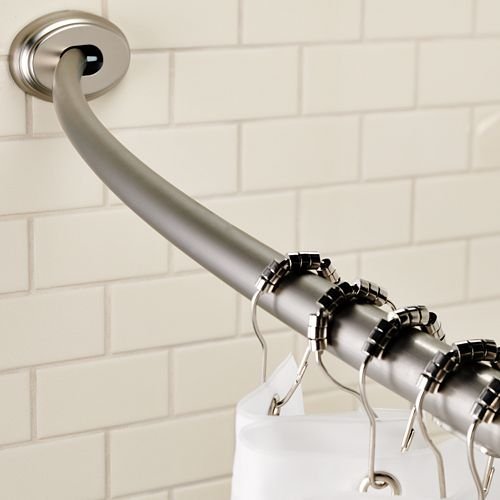The Best Ways to Clean a Shower Curtain and Liner
You get in the shower to get clean, but how clean is your shower itself? If it’s been a while since you cleaned your shower curtain, here’s everything to know about the most effective and efficient methods of cleaning, whether your shower curtain is made of plastic, EVA, vinyl, microfiber, or natural fibers.
While the advice in this article covers cleaning methods for most types of shower curtain, always check your curtain’s label or packaging and follow the care instructions for best results.
How to clean fabric and synthetic shower curtains
The first consideration is what type of shower curtain you have. If you have a fabric curtain made of cotton, linen, polyester, or a blend, it’s as easy to clean as any other cloth in your home. Simply throw it in the washing machine on a cold cycle, and use a mild detergent. If you have a delicate or decorative shower curtain, consider using a mesh laundry bag for extra protection, or wash a towel at the same time to cushion your shower curtain.
Many shower curtains available today are designed to be mold and microbe-resistant. They are often made of plastics like polyester, vinyl, or polymer blends such as EVA, and you might be concerned about how to wash a synthetic shower curtain. Can you put a plastic shower curtain in the washing machine? The answer is yes—shower curtains are designed to withstand lots of hot water, so you should be able to wash any shower curtain in the washing machine on a low heat cycle.
As with natural fabrics, you should use a mild detergent when washing synthetic shower curtains. Take particular care to avoid chlorinated bleach, as it can cause yellowing in white polyester, and can shorten the life of your shower curtain by eating away the outer layer of the material. Remember most synthetic shower curtains are designed to be antimicrobial, so they don’t need to be washed with intensive cleaners.
Pro Tip: For a natural and eco-friendly alternative to bleach, add a cup of white vinegar alongside a small amount of detergent to the washing machine to get your shower curtain fresh and clean.
Once your shower curtain has been washed, you can hang it back up to dry, or tumble dry on a low setting. You can also iron shower curtains with low heat to remove any creases. However many fabrics are treated to be wrinkle-resistant, and if the shower curtain has a weighted hem, often hanging it is enough to smooth it out.
To recap:
- Wash cotton, linen, and other natural shower curtains in the washing machine on a cold cycle
- Use a mesh laundry bag or towel to protect delicate or decorative shower curtains
- Wash synthetic fabrics on a low heat cycle and avoid using chlorine bleach with polyester
- Hang shower curtains to dry, or tumble dry on low
- Allow creases to fall out naturally, or iron on low heat
How to clean a shower curtain liner
If you have a natural fiber shower curtain, you probably use a liner to keep it clean and dry. Shower curtain liners are usually made of synthetic, waterproof and antimicrobial materials such as polyester, EVA, or vinyl. You can wash shower curtain liners in the same way you would wash any synthetic shower curtain. They’re designed to be water and heat resistant, so are perfectly safe being washed on cold setting in the washing machine, and air dried or tumble dried on low.
Hand washing a shower curtain
If you’re worried about placing your shower curtain in the washing machine, or the instructions say not to do that, don’t worry. You can clean your shower curtain and liner just as effectively by hand washing.
Remove the shower curtain from the shower to make it easier to handle. Damp the curtain and sprinkle it with baking soda. You can use the soda to scrub away any soap scum, water stains, or mildew without harming your shower curtain, whatever it’s made from. Use a brush or microfiber cloth to rub the baking soda into the shower curtain until it’s clean, then rinse thoroughly with warm water to remove any residue.
Once the shower curtain is clean, hang it up and let air dry naturally.
While you’re washing your shower curtain…
While your shower curtain and liner are in the laundry, it’s a good time to clean the rest of your shower. Don’t forget the pole, so you’re not hanging your nice clean shower curtain on a grubby rail. Depending on your type of shower curtain, it might use rings or hooks to connect to a pole. These collect as much dirt and grime as anything else in the bathroom, and should be cleaned regularly.
Remove the rings from the pole and put them in the bathroom sink. Fill with hot water and add a couple drops of detergent, or a cup of white vinegar. Let them soak while the curtains are washing, then rinse off before rehanging.
You can also clean your shower curtain pole using an all-purpose bathroom cleaner. Simply spray a little onto a clean cloth and wipe the pole down to remove water marks, dust, and dirt.
How often should I clean a shower curtain?
…Probably more often than you think. Shower curtains sustain a lot of heavy use: regularly being soaked with warm water, kept in a dark, humid environment, collecting soap residue and hard water marks. Even modern shower curtains that are designed to withstand dirt and bacteria need a helping hand to stay clean and fresh. Ideally you should clean your shower curtain once a month to keep it in tip top condition.
Alternatively, you can extend the time between deep cleanings by wiping down your shower curtain during your weekly cleaning routine. Spritz the curtain with an all-purpose cleaner, or a spray bottle filled with white vinegar, and allow it to sit for five minutes before wiping clean. This will go a long way toward keeping your shower curtain stain and mildew free for longer. By keeping to this routine, you can reduce the time between taking down and washing your shower curtains from monthly to around once every three months.
Keeping your shower curtain clean doesn’t have to be difficult with these tips. Most modern curtains can be easily cleaned, and following a simple routine will keep your shower curtain and liner clean and fresh, saving you money on replacements and making your home a nicer place to live.



